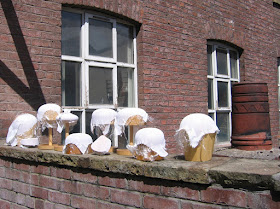This one was made on a weekend course on making silk headpieces, at Hat Works. Silk on its own isn’t stiff enough for hatmaking, so these were made on a buckram base. As ever, the tutors Sue and Marie brought examples to inspire us, both in buckram and silk.
 |
| Buckram bases, |
 |
| - and silk hats |
We actually worked on two hats over the weekend, but the other one is a long way from complete, so will, eventually, get its own post.
For this hat I chose a simple heart-shaped percher block.
 |
| I forgot my ruler, so had to use a pen for scale! |
Because it was impossible to shape the woven buckram over this block without wrinkles, the top and sides were made separately. Unfortunately there are no ‘in progress’ photographs: wet buckram is horribly sticky, and anyone handling wet buckram soon becomes horribly sticky as well, so there was no way I was going to pick up a camera while doing this.
 |
| Shaped buckram pieces drying in the sun |
Once dry, the excess was cut off both blocked pieces, leaving a reasonable overlap on the top section and the tiniest of overlaps on the side piece. These were stitched together, and brim wire sewn round the bottom edge. Then to stop the texture of the buckram from showing through the silk, the wire was covered with a bias strip of tarlatan and the top was covered with a piece of ice wool - a loosely-knitted, fluffy fabric.
 |
| The buckram base, top view and underside |
 |
| Tarlatan edge and ice wool top |
Base completed, it was on to the silk. For this I decided to use a technique I’d seen in The Art of Manipulating Fabric by Colette Wolff. This involved sewing narrow tucks on the right side of the silk . . .
 |
| Hand-sewn pleats |
. . . and adding gathering stitches on the wrong side.
 |
| Gathering stitches, positions alternating between rows |
The gathering stitches were pulled up, and the tucks sewn together on the right side, to give an effect somewhere between pleating and smocking.
 |
| The end result |
I had measured the hat before I started, to make sure that the completed panel would be the right size for it. Some of the excess silk was tucked under the pleated sections at each end, but some I had to pleat along the sides, as I wanted to keep it as a single piece of silk.
 |
| The covered hat |
The resulting little compartments, the richness of the silk, and the shape of the hat all combined to remind me of old-fashioned chocolate boxes; the sort made out of pasteboard and covered with satin, with chocolates in individual paper cases rather than moulded plastic trays. This sort of thing.
 |
| Yum! |
So taking this as my inspiration I decided to bead the hat as though only a handful of chocolates were uneaten, with a few beady crumbs left in the folds of the silk in a couple of the other sections.
 |
| The 'chocolates' and the 'crumbs' |
The lining was made from a curious silk remnant I found in MacCulloch & Wallis last year. As the pattern is printed on the bias, I think that it might have been intended for ties.
 |
| The lining fabric - the orange and purple go well with the hat silk |
The lining was made from a bias strip sewn into a tube and gathered along one long edge, then sewn onto a central patch. Because the lining would not be the same depth all round, I decided to cut it with the stripes radiating rather than forming circles.
 |
| The completed lining |
I actually cheated a bit (sorry, Sue and Marie!) and secured the lining in place with a couple of long threads I’d sewn onto the underside of the buckram base before I attached the silk outer layer. Once in place the lining was cut to shape, the raw edge turned under, and slip-stitched in place.
 |
| Sewn into the hat |
And this is the finished hat. Well, almost finished: it still needs elastic, so for the photos it was worn I little more on top of the head than I'd like.




No comments:
Post a Comment